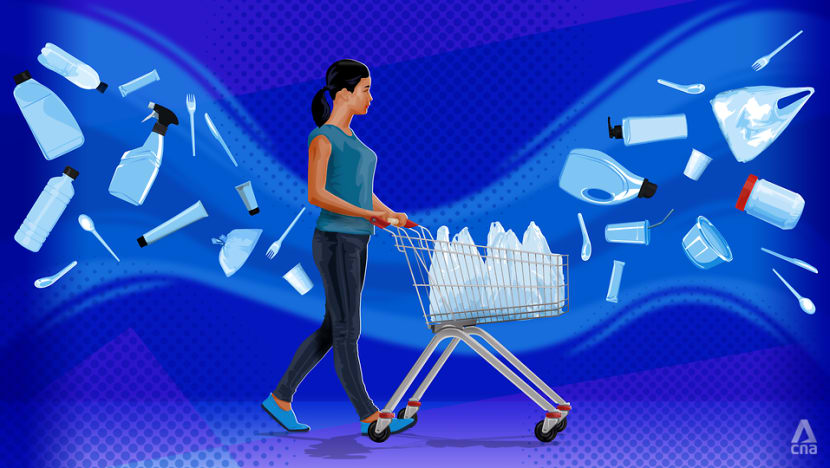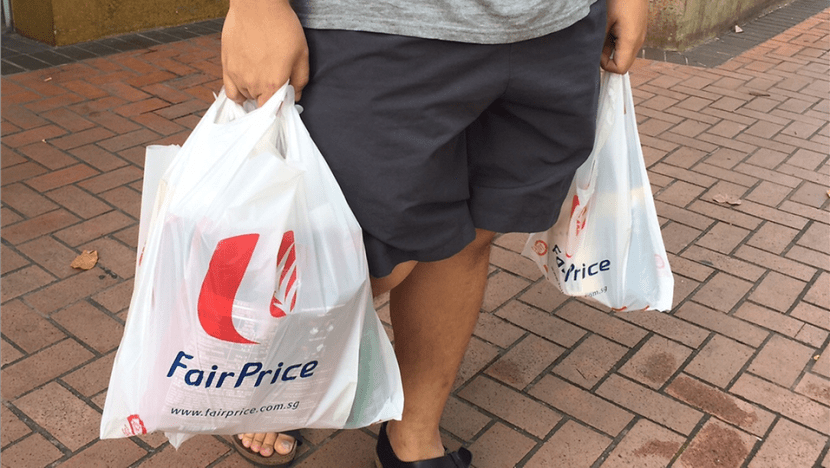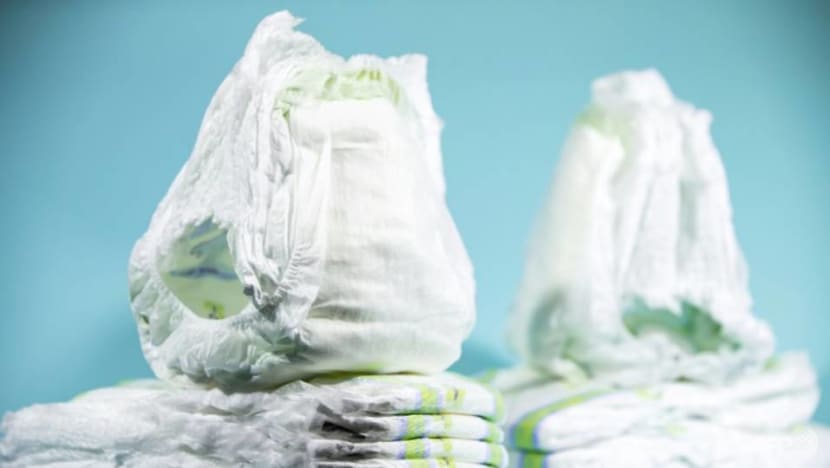commentary Commentary
Commentary: Paying for a plastic bag isn't enough to change our dependence on it
Plastic has become so ubiquitous in our modern world that it will take more than plastic bag bans to purge it from our lives, says Annie Tan.

We want to use less plastic but so much of our daily lives are wrapped in it. (Illustration: Rafa Estrada)
SINGAPORE: Could as little as 10 cents reshape shopping habits and plastic usage? NTUC Fairprice’s No Plastic Bag pilot seems to suggest that it might.
Since charging 10 to 20 cents per transaction for plastic bags at 25 outlets from Nov 2019, between 70 to 90 per cent of customers at participating outlets refused plastic bags.
This initiative saved 15.6 million plastic bags, such that NTUC decided to extend it for another year from Nov 2020.
READ: Watsons to charge for plastic bags on Tuesdays as part of sustainability campaign
Some retailers such as IKEA and Cotton On have long eliminated plastic bags entirely. And this has been gaining momentum with more brands. From Dec 2020, Watsons also began charging 10 cents per transaction for plastic bags across its 100 stores.

Besides grocery bags, the battle has also been waged on takeaway containers, straws and cutlery among other things, with many retailers banning these items, or imposing 20 to 50 cent charges for them.
WE ARE STILL DROWNING IN PLASTIC
Greater environmental awareness and global backlash has made plastic a dirty word. It has come to represent ugly consumerism and thoughtless wastage.
The figures are hard to argue with. Our little island generated 930,000 tonnes of plastic waste in 2019, according to statistics by the National Environmental Agency (NEA). Of this, only 4 per cent was recycled.
Charging for plastic bags and take-out containers seems to have some effect on Singaporean’s lifestyle habits but the answer to our plastic purge may be a lot more complicated than that.
Even before it was fashionable to recycle, 10 years ago, I decided to use less plastic – bringing along a reusable shopping bag and refillable water bottle wherever I went.
I avoided single-use plastic cutlery in most cases, and tried to reuse plastic bags. But purging plastic from my life has been much harder than my modest efforts.
READ: Commentary: A case for making plastic bags in Singapore ugly – or even embarrassing
Plastic seems to have become the very fabric of modern life, from medical supplies to hygiene products and food storage. Which means shopping plastic-free requires next-level manoeuvring.
Like it or not, we get plastic shoved in our faces all the time.
From our Shopee purchase that came in several layers of bubble wrap and plastic packaging to that tiny sandwich via GrabFood that arrived in a mega bag, and even the four slices of cakes from our neighbourhood bakery individually wrapped in plastic, put in a plastic container and then a plastic bag, we are literally drowning in plastic.
READ: Commentary: All these corporate greeting cards and presents are not gifts. They're spam
We can say no to the plastic bags, but eliminating plastic entirely will require nothing short of rearranging our daily routines.
How many retailers, bakeries, brands and eateries would we have to shun, even if they offer our favourite snacks or everyday necessities at better price points.

Everyday acts of eating, drinking, socialising and grocery shopping will involve a lot of forethought, research, and in many cases, a more substantial budget.
We will need to know how each brand packages their stuff before walking into a shop, or ask staff about packaging and alternatives, sometimes despite long queues behind us.
Moreover, only specialty retailers offer plastic-free or refillable groceries and food, usually at a premium. And because these shops are so few and far between, going plastic-free may transform daily grocery runs for shampoo, toothpaste, cooking oil or peanut butter into a special trip requiring at least a couple of hours.
READ: Commentary: Here’s what months of food deliveries and takeaways have taught us
We would also have to plan our social activities and meals out in advance, decide if we are eating in or taking out, and bring the necessary containers and enough water to last the day.
We may even need an app with some social sharing elements to keep track of the plastic practices of retailers, as well as the various ever-changing elements in our lives.
THE PLASTIC PURGE MAY BE MESSY
Another problem is that plastic has become a key part of many modern hygiene practices.
Circling back to the plastic bag war, one practical problem is that many of us line rubbish bins with plastic bags. Yes, there are compostable bin liners, but these add to our grocery cost.
And lining the trash with newspapers or using “naked” bins makes cleaning up food residues and semi-liquid trash a veritable chore.
My family reuses bread loaf bags, toilet paper packaging, diaper packaging and other plastic packaging to line the trash wherever possible, but when those run out, we still turn to plastic bags.
READ: Commentary: Wasteful practices of affluence must stop
So perhaps in addition to discouraging consumers from taking plastic bags, innovators can also come up with viable and affordable plastic-free solutions for taking out the trash?
Basic sanitisation rituals are another mucky issue. The average baby goes through 2,500 to 3,000 diapers, which use plastic in their production – and that is just in their first year.
When I was first expecting, I remember how optimistic I felt after acquiring a small set of cute reusable diapers and diaper liners.

Well, it only took my baby’s first couple of explosive diarrhoea in a mall without a baby changing station and a clean toilet, as well as a particularly persistent diaper rash for me to reconsider my options.
It is not just babies. The average woman is also estimated to go through between 5,000 and 15,000 pads or tampons in their lifetime.
Most tampons incorporate plastic in the absorbent part, strings and packaging; and most pads feature plastic throughout their design from the leak-proof base to the fluid absorbent synthetic materials and packaging.
For a small group of women however, plastic purging has become a crusade. Some for instance, have switched to diva cups, funnel-shaped menstrual cups inserted into the vagina.
Despite their glamorous moniker however, how many women will take to such a transformative way of dealing with something so personal?
READ: Commentary: Climate action is our generation’s 1965
NAVIGATING OUR PLASTIC WORLD
Yet, as consumers, it would certainly help if we simply were more mindful of our everyday decisions.
Simple lifestyle changes such as bringing our own water bottles and reusable shopping bags, reusing plastic, and avoiding poorly designed single-use products and brands that use excessive plastic packaging can have a ripple effect on business practises and product design.

However, the onus should not fall on individuals alone. So much of our modern world is built with plastic that it takes a concerted effect to re-imagine a world without it.
What we need are viable solutions. Besides viable trash disposal solutions, more water coolers in public spaces and malls would cut down the need for plastic bottles for instance.
READ: IN FOCUS: 'It is not easy, but it can be done' - The challenges of raising Singapore's recycling rate
READ: Commentary: Dear Singapore, a plastic future is not fantastic
Fast Moving Consumer Goods (FMCG) titans could also flex their muscles to rethink product design and offer more affordable plastic-free toothbrushes, toothpaste, shampoos, soaps, skincare products, detergents, cotton buds, diapers and sanitary pads, rather than leaving it to niche brands that may charge more and are not so readily accessible.
And perhaps the problem is not just with plastic per se, but the throwaway culture it has spawned as well. If brands and product designers could put more thought into designs that endure, we could eradicate single-use plastic and reduce waste.
Singaporean scientists have also found a way to turn plastic bottles and waste into aerogel, a light, highly insulating and absorbent material that may be used to enhance heat and sound insulation in buildings, line fire-retardant coats, make carbon dioxide absorption masks and clean up oil spills among other things.
Indeed, if governments, companies, scientists, designers, architects and individuals come together to redesign and reinvent modern living, perhaps someday, we will finally walk the plastic talk without having the scramble for a plastic-infused diaper or an out-of-the-box solution simply to take out the trash.
SIGN UP: For CNA’s Commentary weekly newsletter to explore issues beyond the headlines
Annie Tan is a freelance writer.














